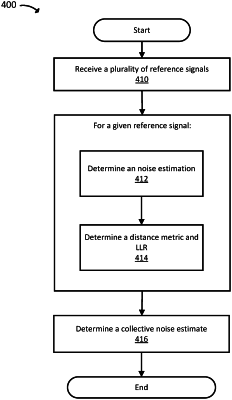| CPC H04L 25/03242 (2013.01) [H04B 7/022 (2013.01); H04B 7/0417 (2013.01); H04B 7/0626 (2013.01); H04L 1/0054 (2013.01); H04L 2025/03426 (2013.01)] | 18 Claims |

|
1. A method for improving noise estimation at a receiver, the method comprising:
receiving a plurality of reference signals;
for a given reference signal:
determining a noise estimation; and
determining a distance metric and a log-likelihood ratio (LLR) of the noise estimation; and
determining a final LLR based on the distance metric and the LLR of each noise estimation;
wherein determining the final LLR further comprises:
combining the LLRs of at least two noise estimations; or
selecting the LLR of a particular noise estimation based on the distance metric of the particular noise estimation;
wherein for a first reference signal of the plurality of reference signal, the noise estimation is a first noise estimation, the distance metric is a first distance metric, and the LLR is a first LLR;
for a second reference signal of the plurality of reference signals, the noise estimation is a second noise estimation, the distance metric is a second distance metric, and the LLR is a second LLR;
wherein the method further comprises:
determining a combined noise estimate, wherein determining the combined noise estimate comprises:
combining the first LLR and the second LLR; or
determining that the second distance metric is nearer to a threshold value than the first distance metric; and determining the combined noise estimate according to the second noise estimation.
|